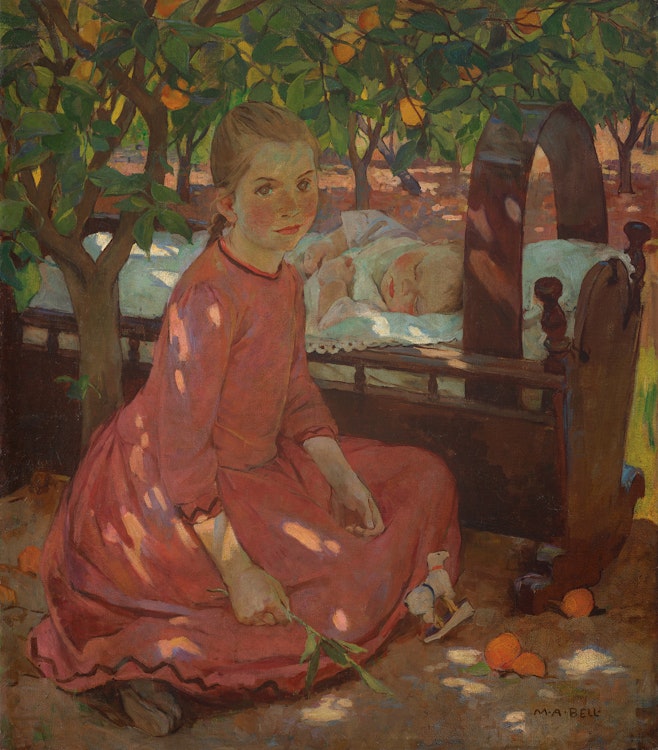In the Orchard, circa 1895-1897 by Mary Alexandra Bell Eastlake

Mary Eastlake
In the Orchard, circa 1895-1897
oil on canvas
signed lower right
38 x 33.25 ins ( 96.5 x 84.5 cms )
Auction Estimate: $30,000.00 - $50,000.00
Price Realized $168,000.00
Sale date: June 8th 2023
Sotheby’s, auction, Toronto, 2 October 1974, lot 14 G.
Blair Laing Ltd., Toronto
Mr. & Mrs. Kenneth R. Thomson, Toronto
A.K. Prakash & Associates, Inc., Toronto
Masters Gallery, Calgary
Acquired by the present Private Collection, 2011
“Embracing Canada: Landscapes from Krieghoff to the Group of Seven”, Vancouver Art Gallery; travelling to the Glenbow Museum, Calgary; Art Gallery of Hamilton, 30 October 2015‒25 September 2016
“Canada and Impressionism: New Horizons 1880‒1930”, National Gallery of Canada, Ottawa; travelling to Kunsthalle der Hypo‒Kulturstiftung, Munich; Fondation de l’Hermitage, Lausanne; Musée Fabre, Montpellier, 19 July 2019‒3 July 2021, no. 60
Ian Thom, et al., “Embracing Canada: Landscapes from Krieghoff to the Group of Seven,” Vancouver/London, 2015, page 60, reproduced page 81
Katerina Atanassova, “Canada and Impressionism: New Horizons 1880‒1930”, Ottawa, 2019, no. 60, pages 253, 278 note 69, reproduced page 185
Although not exclusively a figure painter, Bell Eastlake was best known for her depictions of girls and women in domesticated outdoor settings: subjects widely considered appropriate for women artists at the time. The girl and the baby in “In the Orchard” might be sisters, although their juxtaposition also underscored stereotypes about the natural evolution of girls into future mothers. Among Bell Eastlake’s contemporaries, artists such as Mary Cassatt, Helen McNicoll and Laura Muntz Lyall were also renowned for their views of young women, girls and babies. Indeed, as Katerina Atanassova has noted, the influence of Cassatt’s prints may be seen in the flatness and in the outlined forms of In the Orchard; Bell likely saw Cassatt’s prints when they were exhibited at the Galerie Durand‒Ruel in Paris in 1891.
Surveying Bell Eastlake’s career in 1925, “The Studio” described her work as “essentially decorative. She has a strong sense of rhythm and pattern. Her colour, which is pure and strong, is usually put down in flat tones, whether the medium be pastel, oil colour, or gouache. The characterisation of her portraits and figure subjects is excellent ... She excels in depicting babies and young children.” All of these qualities are present in In the Orchard, where the two figures are placed in a space whose shallowness is enhanced by the highly decorative fruit trees that both delimit the space and echo the decoratively curving elements of the cradle. By having the kneeling girl look straightforwardly at the spectator, Bell avoided the excessive sentimentality that often bedevilled paintings of children, while the warm colouring and dappled sunlight lend an immediacy that combines the freshness of Impressionism with a post-impressionist interest in outline and design. In the words of the art critic for journal “The Week”, writing in 1895 about another of Bell’s child-themed paintings (but with words that could as easily be applied to In the Orchard), the picture was “simply and solidly painted; a little piece of decoration which would give life and colour to a large space in many a drawing-room”.
Bell Eastlake only occasionally signed, and almost never dated, her canvases, but there are rare examples of comparable views of girls and young women in gardens that she signed with her married name (e.g., “Blue and Gold”; National Gallery of Canada). “In the Orchard” is signed “M.A. Bell”, and is therefore presumed to have been painted before her 1897 marriage, although as late as 1927 the Toronto Star noted that “Mrs. C.H. Eastlake ... is perhaps better known in Toronto as M.A. Bell.” Her work from earlier in the 1890s tended to be based on a more conservative palette, and it therefore seems reasonable to date “In the Orchard” to the middle years of the decade.
We extend our thanks to Brian Foss, Carleton University Chancellor’s Professor of Art & Architectural History, and co‒curator of “1920s Modernism in Montreal: The Beaver Hall Group” for his assistance in researching this artwork and for contributing the preceding essay.
Share this item with your friends
Mary Alexandra Bell Eastlake
(1864 - 1951)
Born at Douglas, Ontario, she spent her early life in Almonte and Carillon, Quebec, where her father was engaged in the construction of the Carillon Dam. She was a student of Robert Harris in Montreal and later studied in Paris where she attended the Académie Colarossi and exhibited at the Salon. She went to England and settled at St. Ives where she met and married English landscapist C. H. Eastlake. They became designers and made jewellery and enamels.
She exhibited with the Royal Academy, the Royal Institute of Painters in Oils, and the London Pastel Society. The Studio once described her work as follows, “. . . Mrs. Eastlake’s work is essentially decorative. She has a strong sense of rhythm and pattern. Her colour, which is pure and strong, is usually put down in flat tones, whether the medium be pastel, oil colour or gouache . . .” She also visited the U.S.A. where she exhibited with the New English Art Club, Boston, and with other groups at New York, Philadelphia, and Chicago. She paid several visits to Canada and finally stayed, with her husband, in 1939. They spent several years in Montreal and later moved to Almonte, Ontario.
Her pictures of children bring to mind the work of Mary Cassatt, American artist. The National Gallery of Canada has several canvases by her, some landscapes, portraits, and figure studies. She signed her canvases M.A. Bell, and after marriage, M.A. Eastlake. One of her largest Canadian exhibitions was held at the Art Gallery of Toronto during the winter 1927. She died in Ottawa.
Sources: "A Dictionary of Canadian Artists, Volume I: A-F", compiled by Colin S. MacDonald, Canadian Paperbacks Publishing Ltd, Ottawa, 1977

